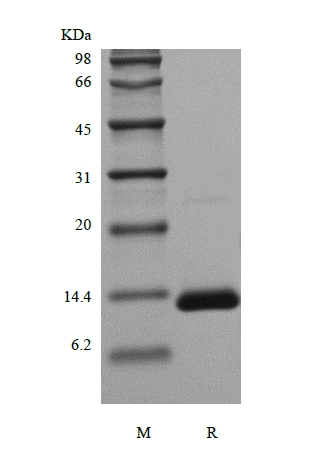| Official Full Name |
Recombinant Human Transforming Growth Factor – beta 1 (rHuTGF-beta1) |
| Squence |
 |
| Amino Acid Sequence |
|
| Synonyms |
|
| Accession Number |
|
| GeneID |
|
| Summary |
|
| Source |
Chinese Hamster Ovary cell line, CHO |
| Molecular Weight |
|
| Biological Activity |
Measured by its ability to inhibit the IL-4-dependent proliferation of HT‑2 mouse T cells. The ED50 for this effect is 0.04-0.2 ng/mL. The specific activity of rHuTGF-beta1 is approximately 2.5 × 104 U/ug, which is calibrated against human TGF-beta1 Standard. |
| Appearance |
Sterile Filtered White lyophilized (freeze-dried) powder. |
| Formulation |
Lyophilized from 0.2 um filtered concentrated solution in 35 % Acetonitrile and 0.1 % TFA. |
| Endotoxin |
Less than 0.1 EU/ug of rHuTGF-beta1 as determined by LAL method. |
| Reconstitution |
We recommend that this vial be briefly centrifuged prior to opening to bring the contents to the bottom. Reconstitute in sterile 4 mM HCl to a concentration of 0.1 mg/ml. Stock solutions should be apportioned into working aliquots and stored at ≤ -20 °C. Further dilutions should be made in appropriately buffered solutions. |
| Stability and Storage |
Use a manual defrost freezer and avoid repeated freeze-thaw cycles.- 12 months from date of receipt, -20 to -70 °C as supplied.- 1 month, 2 to 8 °C under sterile conditions after reconstitution.- 3 months, -20 to -70 °C under sterile conditions after reconstitution. |
| References |
TGF-beta 1 (transforming growth factor beta 1) is one of three closely related mammalian members of the large TGF-beta superfamily that share a characteristic cystine knot structure. TGF-beta 1, -2 and -3 are highly pleiotropic cytokines that are proposed to act as cellular switches that regulate processes such as immune function, proliferation and epithelial-mesenchymal transition. Each TGF-beta isoform has some non‑redundant functions; for TGF-beta 1, mice with targeted deletion show defects in hematopoiesis and endothelial differentiation, and die of overwhelming inflammation. TGF‑ beta is activated from latency by pathways that include actions of the protease plasmin, matrix metalloproteases, thrombospondin 1 and a subset of integrins. Mature human TGF‑ beta 1 shares 100% aa identity with pig, dog and cow TGF‑ beta 1, and 99 % aa identity with mouse, rat and horse TGF‑beta 1. |
| SDS-PAGE |
 |
| Safety Data Sheet (SDS) Download |
Click to download |
| Technical Data Sheet (TDS) Download |
Click to download |



